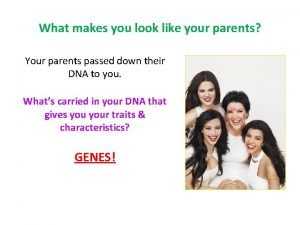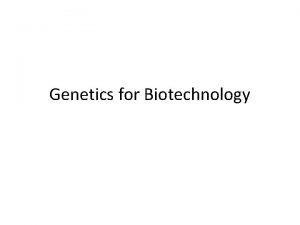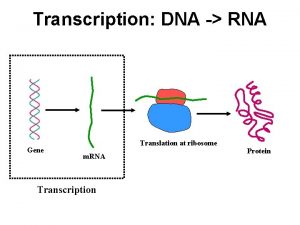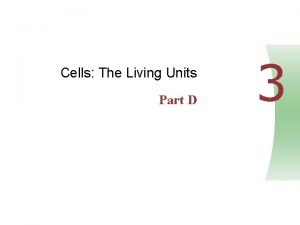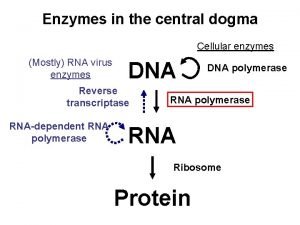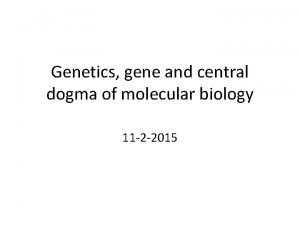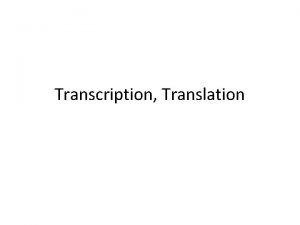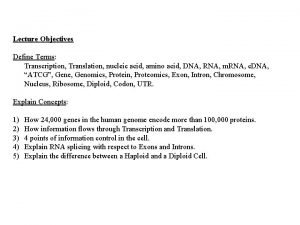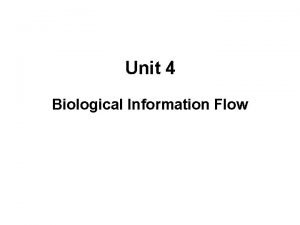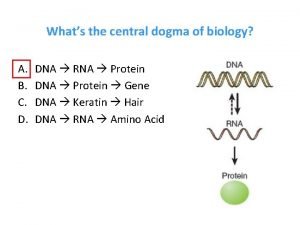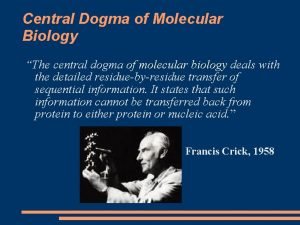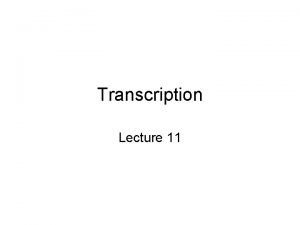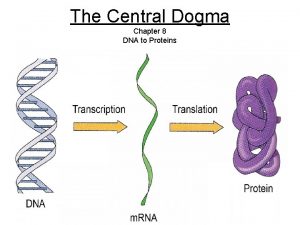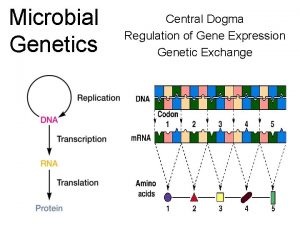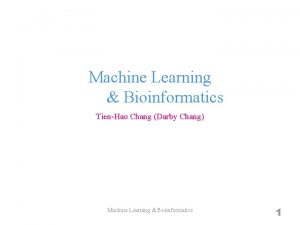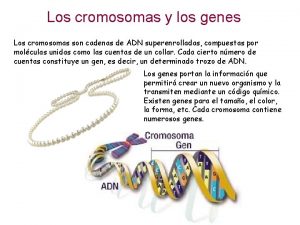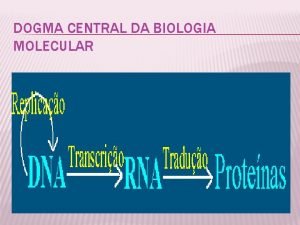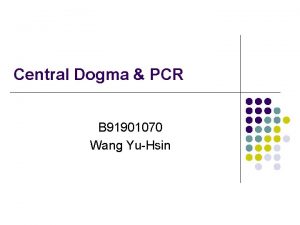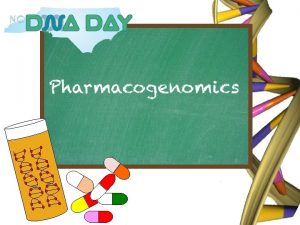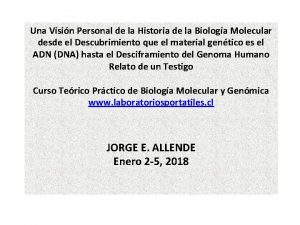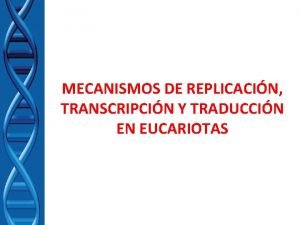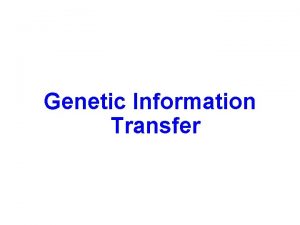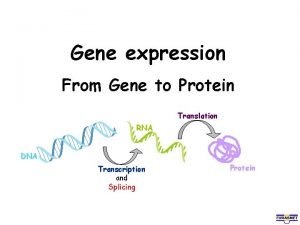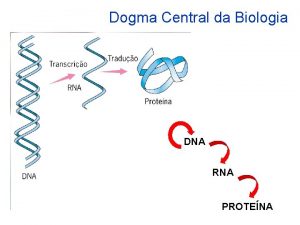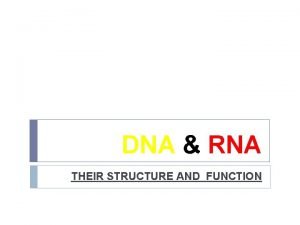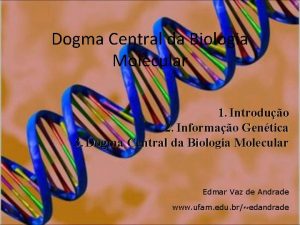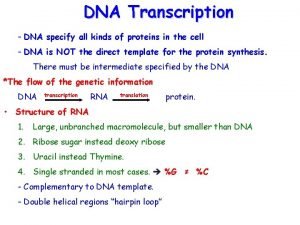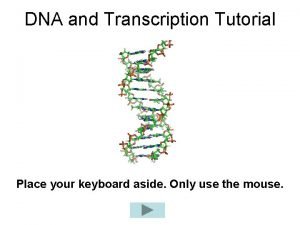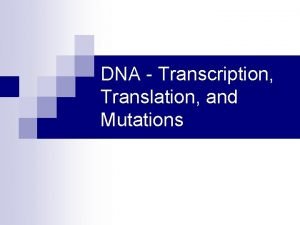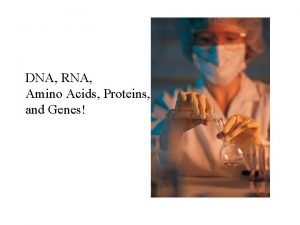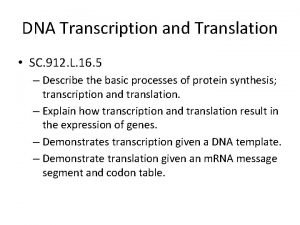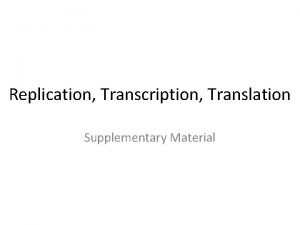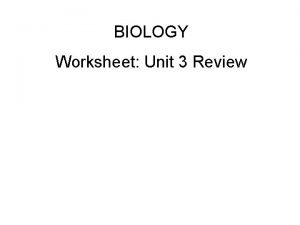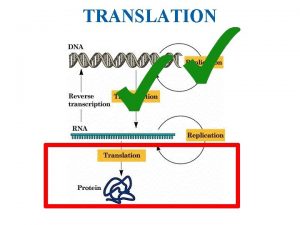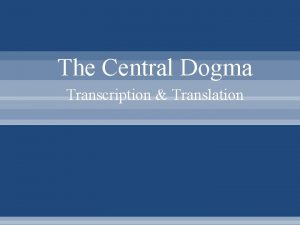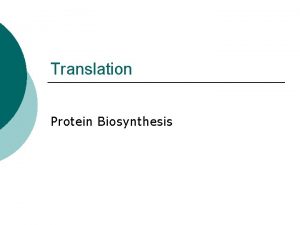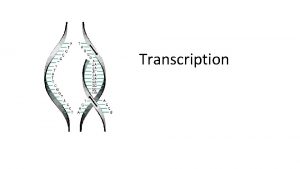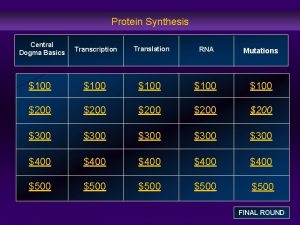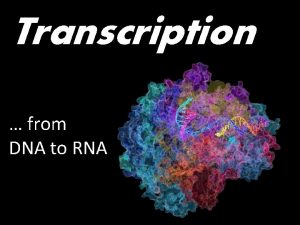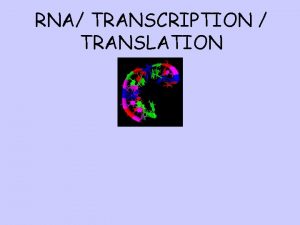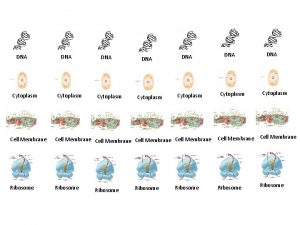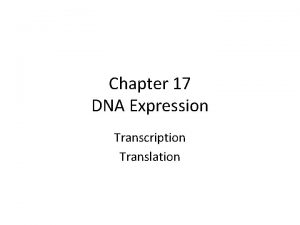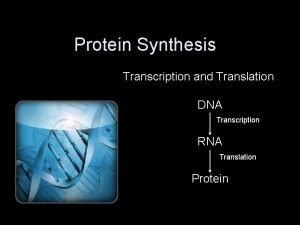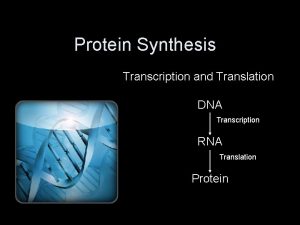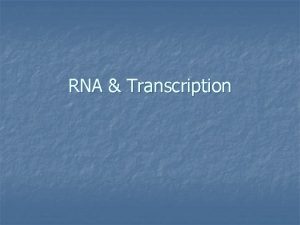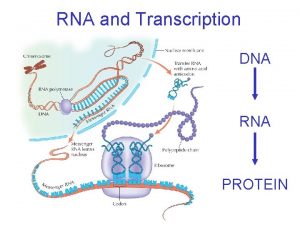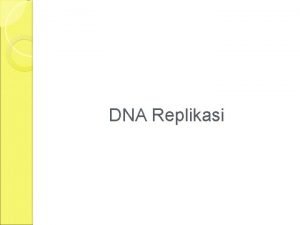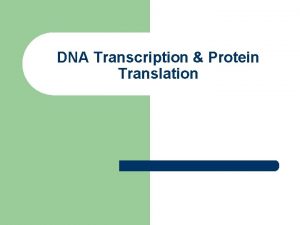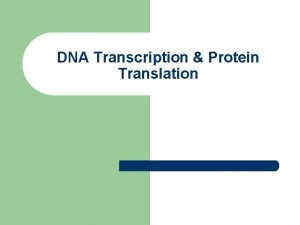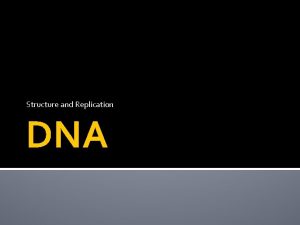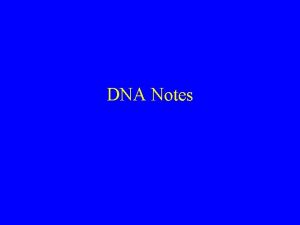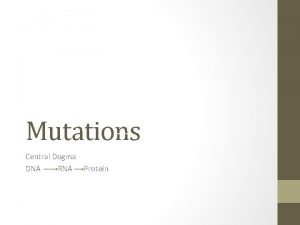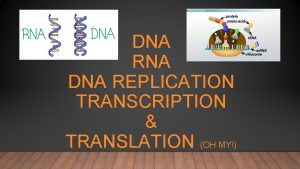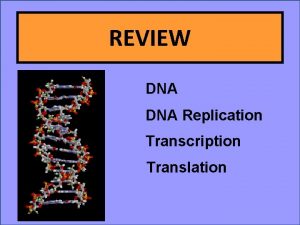Central Dogma DNA Nucleus Transcription RNA Cytoplasm Translation






































- Slides: 38

Central Dogma DNA (Nucleus) Transcription RNA (Cytoplasm) Translation Protein

DNA and Protein Synthesis DNA RNA Transcription One gene is a segment of DNA Protein Trait Translation Structural proteins Physical Traits Enzymatic proteins Metabolic Traits Hormonal proteins Control of Growth and Development

Ribo. Nucleic Acid - RNA • RNA is composed of long chains (polymer) of nucleotides containing a nitrogenous base, ribose sugar and a phosphate. • RNA comes in a variety of different shapes and types.

Function of RNA The main function of RNA is to convert the information stored in DNA to make proteins.

Protein Synthesis Requires Three Types of RNA 1. m. RNA Messenger RNA 2. t. RNA Transfer RNA 3. r. RNA Ribosomal RNA

Messenger RNA (m. RNA) molecules carry copies of instructions for making proteins from the nucleus to the ribosome. m. RNA copies are made from a DNA template.

Transfer RNA (t. RNA) t. RNA molecules carry amino acids to the ribosome and transfers it to a growing protein chain.

Ribosomal RNA (r. RNA) • r. RNA is a part of ribosomes, which help to build proteins. codon • Couples m. RNA codons with t. RNA anticodons during protein synthesis.

RNA vs DNA RNA • • DNA single stranded short ( 1 gene) ribose sugar uracil (U) Nitrogenous Base • • double stranded long (many genes) deoxyribose sugar thymine (T) Sugar Phosphate Backbone Nitrogenous Base Sugar Phosphate Backbone

DNA RNA Deoxyribose Sugar Ribose Sugar Thymine Uracil Double Stranded Single Stranded

How does the information from the DNA in the nucleus get to the cytoplasm? m. RNA!

DNA Transcription • m. RNA is formed from DNA by a process called DNA transcription • DNA is transcribed (copied) to m. RNA • m. RNA goes from the nucleus to the ribosomes in the cytoplasm

Difference between DNA Replication and DNA Transcription DNA replication • DNA replication copies the whole DNA strand • Creates two identical copies • Uses thymine (T) DNA transcription • DNA transcription copies small sections (genes) • Creates one single strand (m. RNA) • Uses uracil (U)

Steps of Transcription (occurs in the nucleus) 1. Initiation 2. Elongation 3. Termination

Step 1: Initiation DNA unwinding and unzipping along base pairs RNA polymerase finds the DNA and unwinds/unzips the DNA strands.

Step 2: Elongation m. RNA forming Free bases • RNA polymerase uses one strand of DNA as a template to assemble free nucleotides into m. RNA using complementary base pairing rules. • Cytosine (C) pairs with Guanine (G) • Adenine (A) pairs with Uracil (U)

Step 3: Termination • Newly synthesized m. RNA strand is released from DNA template. • The m. RNA leaves the nucleus and enters the cytoplasm. • DNA re-zips and retwists.

You. Tube Video DNA Transcription

Central Dogma DNA (Nucleus) Transcription RNA (Cytoplasm) Translation Protein

Translation = Conversion of m. RNA into an amino acid sequence that makes a protein.

How does the information on the m. RNA strand get translated to amino acids and proteins? Codons!

Parts of the Translation Machinery • m. RNA • t. RNA • Ribosome (r. RNA) • Amino acids

Translation of m. RNA into Amino Acids • The “words” of the DNA “language” are triplets of bases called CODONS 3 bases = 1 triplet = 1 codon - located on m. RNA

Codons on m. RNA sequence The order of codons in a gene specify the amino acid sequence of a protein. Every protein has a unique sequence of amino acids.

20 Amino Acids Alanine Arginine Asparagine Aspartic acid Cysteine Glutamic acid Glycine Histidine Isoleucine ala arg asn asp cys gln glu gly his ile A R N D C Q E G H I Leucine Lysine Methionine Phenylalanine Proline Serine Threonine Tryptophan Tyrosine Valine leu lys met phe pro ser thr trp tyr val L K M F P S T W Y V

The Genetic Code met START The codon is either translated into an amino acid or serves as a start/stop signal.

Translation of m. RNA into Amino Acids The genetic code is a sequence of triplets or codons in a specific order, to make a protein.

How are the amino acids brought together to make proteins? t. RNA!

Transfer RNA (t. RNA) Amino Acid Each t. RNA molecule is specific for one amino acid. It carries an amino acid on one end an anticodon on the other end. Anticodon

Transfer RNA (t. RNA) codon anticodon on od antic The anticodon is complementary to the 3 bases of the codon on the m. RNA molecule.

Steps of Translation (occurs in the cytoplasm) 1. Initiation 2. Elongation 3. Termination

Step 1: Inititaion Start codon AUG Ribosome attaches to the m. RNA. Start codon on m. RNA is always AUG.

Step 2: Elongation codon codon anticodon Peptide bond t. RNA anticodon matches with codon on m. RNA. Pepetide bonds are formed between amino acids.

Step 2: Elongation Ribosome codon o ic t n n do codon anticodon a Growing Amino Acid Chain ant ico don t. RNA Amino acid released from t. RNA. Ribosome moves along the m. RNA and continues adding amino acids.

Step 3: Termination Amino Acid Chain Translation ends when a stop codon (UAA, UAG, UGA) is reached. m. RNA and protein (amino acid chain) are released into the cytoplasm.

Central Dogma Summary

You. Tube Video m. RNA Translation

Stop Here
 Dna rna protein central dogma
Dna rna protein central dogma Dna rna protein central dogma
Dna rna protein central dogma Ribosomem
Ribosomem Venn diagram dna and rna
Venn diagram dna and rna Dna to rna transcription
Dna to rna transcription Enzymes involved in central dogma
Enzymes involved in central dogma Molecular biology
Molecular biology Dna coloring transcription and translation
Dna coloring transcription and translation Dna transcription and translation
Dna transcription and translation Dna replication transcription and translation
Dna replication transcription and translation Dna and genes chapter 11
Dna and genes chapter 11 Rna transcription
Rna transcription Whats the central dogma of biology
Whats the central dogma of biology Whats the central dogma of biology
Whats the central dogma of biology Central dogma
Central dogma Central dogma
Central dogma Central dogma cartoon
Central dogma cartoon Central dogma
Central dogma Dogma central
Dogma central Dogma central
Dogma central Central dogma
Central dogma Antidepressant side effects
Antidepressant side effects Autoradiograma
Autoradiograma Que es el dogma central de la biologia
Que es el dogma central de la biologia Semiconservative replication
Semiconservative replication Central dogma of biology
Central dogma of biology Dogma central da biologia
Dogma central da biologia Central dogma diagram
Central dogma diagram Dogma central da biologia
Dogma central da biologia Dna transcription
Dna transcription Dna and transcription tutorial
Dna and transcription tutorial Transcription initiation in eukaryotes
Transcription initiation in eukaryotes Dna code
Dna code Dna transcription
Dna transcription Dna transcription
Dna transcription Perbedaan replikasi virus dna dan rna
Perbedaan replikasi virus dna dan rna Transcription translation replication
Transcription translation replication Transcription translation replication
Transcription translation replication Protein synthesis bbc bitesize
Protein synthesis bbc bitesize
